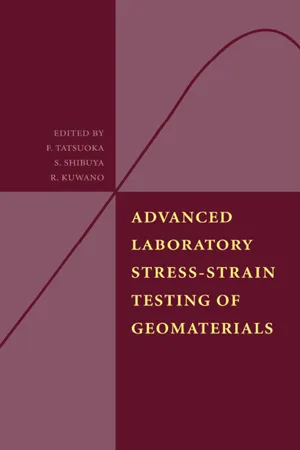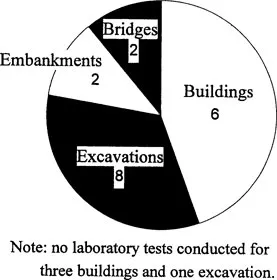
This is a test
- 340 pages
- English
- ePUB (mobile friendly)
- Available on iOS & Android
eBook - ePub
Advanced Laboratory Stress-Strain Testing of Geomaterials
Book details
Book preview
Table of contents
Citations
About This Book
A discussion of developments in the measurement and interpretation of advanced laboratory stress-strain testing of geomaterials. It includes a collection of case studies which apply the test results and is based on the activities of the technical committee No 29 of the ISSMGE.
Frequently asked questions
At the moment all of our mobile-responsive ePub books are available to download via the app. Most of our PDFs are also available to download and we're working on making the final remaining ones downloadable now. Learn more here.
Both plans give you full access to the library and all of Perlego’s features. The only differences are the price and subscription period: With the annual plan you’ll save around 30% compared to 12 months on the monthly plan.
We are an online textbook subscription service, where you can get access to an entire online library for less than the price of a single book per month. With over 1 million books across 1000+ topics, we’ve got you covered! Learn more here.
Look out for the read-aloud symbol on your next book to see if you can listen to it. The read-aloud tool reads text aloud for you, highlighting the text as it is being read. You can pause it, speed it up and slow it down. Learn more here.
Yes, you can access Advanced Laboratory Stress-Strain Testing of Geomaterials by R. Kuwano in PDF and/or ePUB format, as well as other popular books in Technology & Engineering & Civil Engineering. We have over one million books available in our catalogue for you to explore.
Information
Report on applications of laboratory stress-strain test results of geomaterials to geotechnical practice in Japan
University of Tokyo, Japan
Tokyo Metropolitan University, Japan
Takenaka Research And Development Institute, Japan
Kobe University, Japan
Kyusyu University, Japan
Oyo Corporation, Japan
ABSTRACT: As a part of the activities of the Technical Committee TC-29, typical case histories in Japan of the applications of advanced laboratory stress-strain test results of geomaterials to geotechnical practice are summarized. They consist of eighteen cases: eight buildings, two bridges, two LNG tanks, one nuclear power plant, one rock-fill dam, one road embankment, one tunnel, one subway station and one test site for vertical shaft and tunnels. Advanced triaxial tests were conducted in twelve cases, among which axial strains were measured locally in eight cases. In six cases, the laboratory test results were employed before construction to predict full-scale behavior. In the other cases, they were used during/after construction to simulate full-scale behavior and to analyze field test results.
1 INTRODUCTION
Recent developments in laboratory testing techniques have made it possible to evaluate the stress-strain relationships of geomaterials much more addurately than it was before, as reviewed by Tatsuoka et al. (1997). At the same time, field measurement techniques to evaluate in-situ soil properties, often performed prior to construction, and to observe the full-scale behavior of actual structures during and after construction have been improved remarkably. Comparisons between results of relevant laboratory stress-strain tests and field measurements have been made by several researchers, and some Japanese case histories were reported by Tatsuoka and Kohata (1995).
In the above-mentioned circumstances, Technical Committee TC-29 of the International Society for Soil Mechanics and Foundation Engineering was established in 1994 in order; a) to promote cooperation and exchange of information about recent developments in laboratory stress-strain testing; b) to develop recommendations for procedures referred to triaxial and torsional shear tests; and c) to work out a uniform frame for the comparison of stiffness measured by means of different laboratory techniques, with emphasis on their relevance for the solution of problems of practical interest. In relation to term c), an inquiry was made among overseas members of TC-29 into case histories on the applications of laboratory stess-strain test results of geomaterials to geotechnical practice, as has been summarized by Higgins and Jardine (1997) for their experiences in the United Kingdom.
This report summarizes eighteen Japanese case histories collected by Japanese members of TC 29.committee’s preliminary study.
2 JAPANESE CASE HISTORIES
Table 1 summarizes the collected Japanese case histories. Further information on them, along with references, is described in the Appendices, and includes the following: a) construction period, b)location, c) type of project, d) ground conditions, e) laboratory tests, f) field tests, and g) agreement between prediction/simulation and measurement. These are eighteen cases in total, consisting of eight excavation works, six building foundations, two bridge foundations, and two embankment works for a rock-fill dam and a road embankment (Fig. 1). The excavation works include one nuclear power plant, two LNG tanks, one tunnel, one subway station built by an open-cut method, and one test site for a vertical shaft and tunnels. The location of each site is indicated in Fig. 2.

Fig. 1 Types of projects

Fig. 2 Location of sites listed in Table 1
Table 1. Summary of case histories in Japan
No. | Type of project | Ground conditions | Lab./field tests | Application of lab. test results |
JP-1 | Bridge foundation (Akashi Kaikyo Bridge) | Gravels and sedimentary soft rocks | Triax.*, unconf./seismic survey, PLT, PMT | Pre/post-analysis of seismic behavior, post-analysis of full-scale behavior during construction and PLT results |
JP-2 | Bridge foundation (Rainbow Bridge) | Sedimentary soft rocks | Triax.*, oedometer/seismic survey, PLT, PMT | Post-analysis of full-scale behavior during construction |
JP-3 | Excavation (Sagamihara test site) | Sedimentary soft rocks | Triax.*, unconf., ultrasonic log, oedometer/seismic survey, PLT, PMT | Post-analysis of full-scale behavior during excavation and PLT/PMT results |
JP-4 | Excavation (LNG tanks at Negishi) | Sedimentary soft rocks | Triax., unconf., ultrasonic log, sprit/seismic survey, PMT | Pre/post analysis of full-scale behavior during excavation |
JP-5 | Excavation (Nuclear power plant) | Sedimentary soft rocks | Triax.*/seismic survey, PLT, PMT | Post-analysis of full-scale behavior during excavation |
JP-6 | High-rise building | Sedimentary soft rocks | -/Seismic survey | (Pre-analysis of full-scale behavior during co... |
Table of contents
- Cover
- Half Title
- Title Page
- Copyright Page
- Table of Contents
- Preface
- Recent advances in stress-strain testing of geomaterials in the laboratory; background and history of TC-29 for 1994 - 2001
- S-O-A Reports (National reports and international round-robin tests)
- Report on the current situation of laboratory stress-strain testing of geomaterials in Italy and its use in practice
- A review of laboratory equipments for stress-strain testing in Greece
- Recent state of laboratory stress-strain tests on geomaterials in Japan
- A review of Japanese standards for laboratory shear tests
- International round-robin test organized by TC-29
- Report on applications of laboratory stress-strain test results of geomaterials to geotechnical practice in Japan
- Individual papers
- Viscous deformation in triaxial compression of a dense well-graded gravel and its model simulation
- Modelling of stress and strain relationship of dense gravel under large cyclic loading
- Investigation of tied-back wall behavior and selection of geomechanical parameters for numerical analysis
- Small strain stiffness under different isotropic and anisotopric stress conditions of two granular granite materials
- Viscous and non viscous behaviour of sand obtained from hollow cylinder tests
- Micaceous sands: stress-strain behaviour and influence of initial fabric
- Effect of ageing on stiffness of loose Fraser River sand
- Deformation characteristics of recompressed volcanic cohesive soil
- Effects of ageing on stress-strain behaviour of cement-mixed sand
- Dependency of horizontal and vertical sugrade reaction coefficients on loading width
- Low-strain stiffness and material damping ratio coupling in soils
- A solid cylinder torsional shear device
- Application of an elasto-viscous model to one-dimensional consolidation of clay under cyclic loading
- Effects of stress path on the flow rule of sand in triaxial compression
- Simulation of viscous effects on the stress-strain behaviour of a dense silty sand
- Interrelationship between the metastability index and the undrained shear strength of six clays
- Case study on the practical use of elastic modulus in deformation analysis of soft clay ground
- Effects of fabric anisotropy of a sand specimen on small strain stiffness measured by the bender element method
- Strength and deformation characteristics of artificially cemented clay with dispersion due to the mixing quality
- Author index